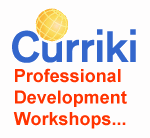By Janet Pinto, Chief Academic Officer, Curriki
Physics is not only interesting, but also helps us to understand how things work – whether it’s understanding kinetic energy in a looping roller coaster, or why your singing voice sounds so much better in the shower.
At Curriki, we have thousands of resources for teaching and learning physics. Here are a few of our favorites that can be used as part of the Flipped Classroom:
Coaster Creator
 Learn the physics of roller coasters with this free, online game that allows students to explore kinetic and potential energy. Per Curriki Member Anna, “This is a great visual aid for students to understand potential and kinetic energy. In addition, it is engaging students to create a roller coaster on their own in order to experiment on what factors affect the change in energy.”
Learn the physics of roller coasters with this free, online game that allows students to explore kinetic and potential energy. Per Curriki Member Anna, “This is a great visual aid for students to understand potential and kinetic energy. In addition, it is engaging students to create a roller coaster on their own in order to experiment on what factors affect the change in energy.”
Full Physics Course from Sal Khan
You’ll find about 100 straightforward 10 – 15 minute tutorial videos comprised of simple graphics and personable narration, covering all topics in a complete high school or college course in Physics.
Physics Videos from STEMbite
 These short video clips are created by online science and math teacher, Andrew Vanden Heuvel, from Michigan, USA. Using Google Glass he makes bite-sized videos highlighting the science in our everyday lives. The extensive Physics collection features such engaging topics as the physics involved in tennis, playrooms, and even singing in the shower!
These short video clips are created by online science and math teacher, Andrew Vanden Heuvel, from Michigan, USA. Using Google Glass he makes bite-sized videos highlighting the science in our everyday lives. The extensive Physics collection features such engaging topics as the physics involved in tennis, playrooms, and even singing in the shower!
The Physics of Sailing
 Inspired by the America’s World Cup, Curriki just announced a new project-based learning (PBL) course that will be available shortly called The Physics of Sailing. Thanks to a grant from Oracle Corporation, the project will be developed by Curriki’s PBL team with contributions from sailing experts from Oracle Team USA.
Inspired by the America’s World Cup, Curriki just announced a new project-based learning (PBL) course that will be available shortly called The Physics of Sailing. Thanks to a grant from Oracle Corporation, the project will be developed by Curriki’s PBL team with contributions from sailing experts from Oracle Team USA.
Do us a favor please and share this with someone who’s interested in physics.













